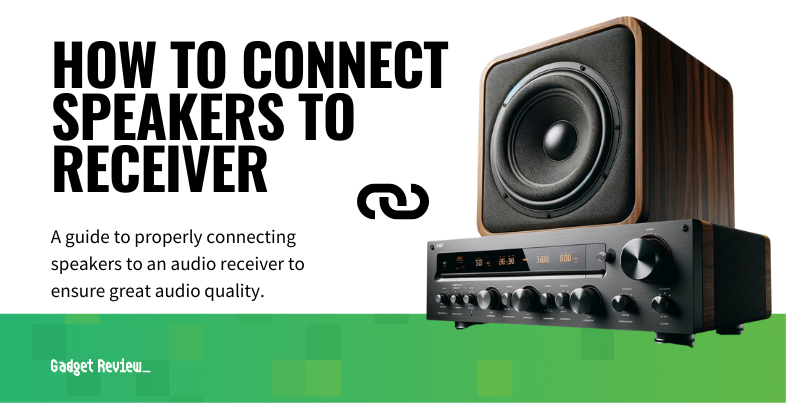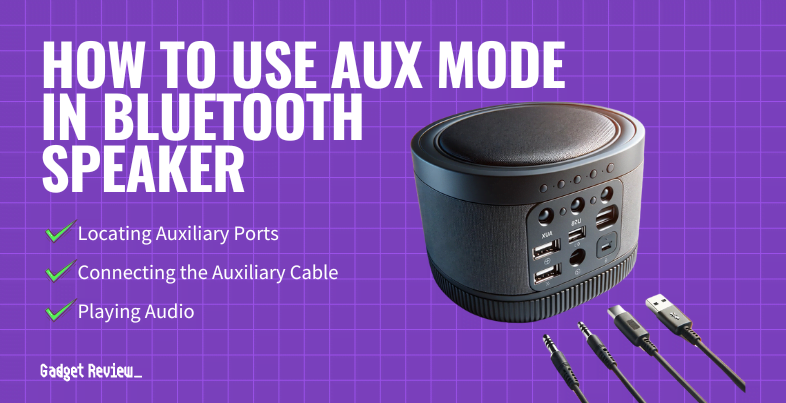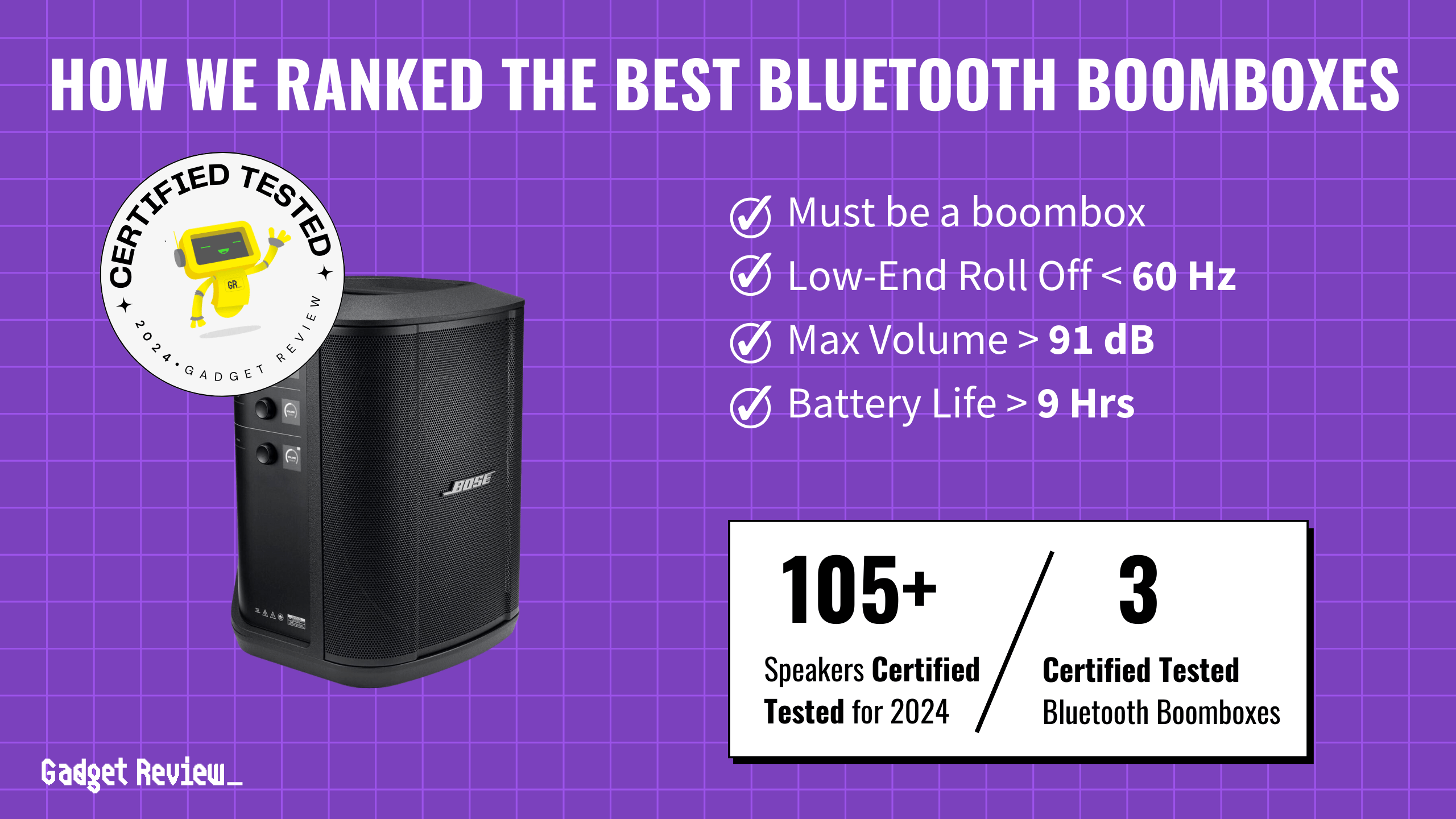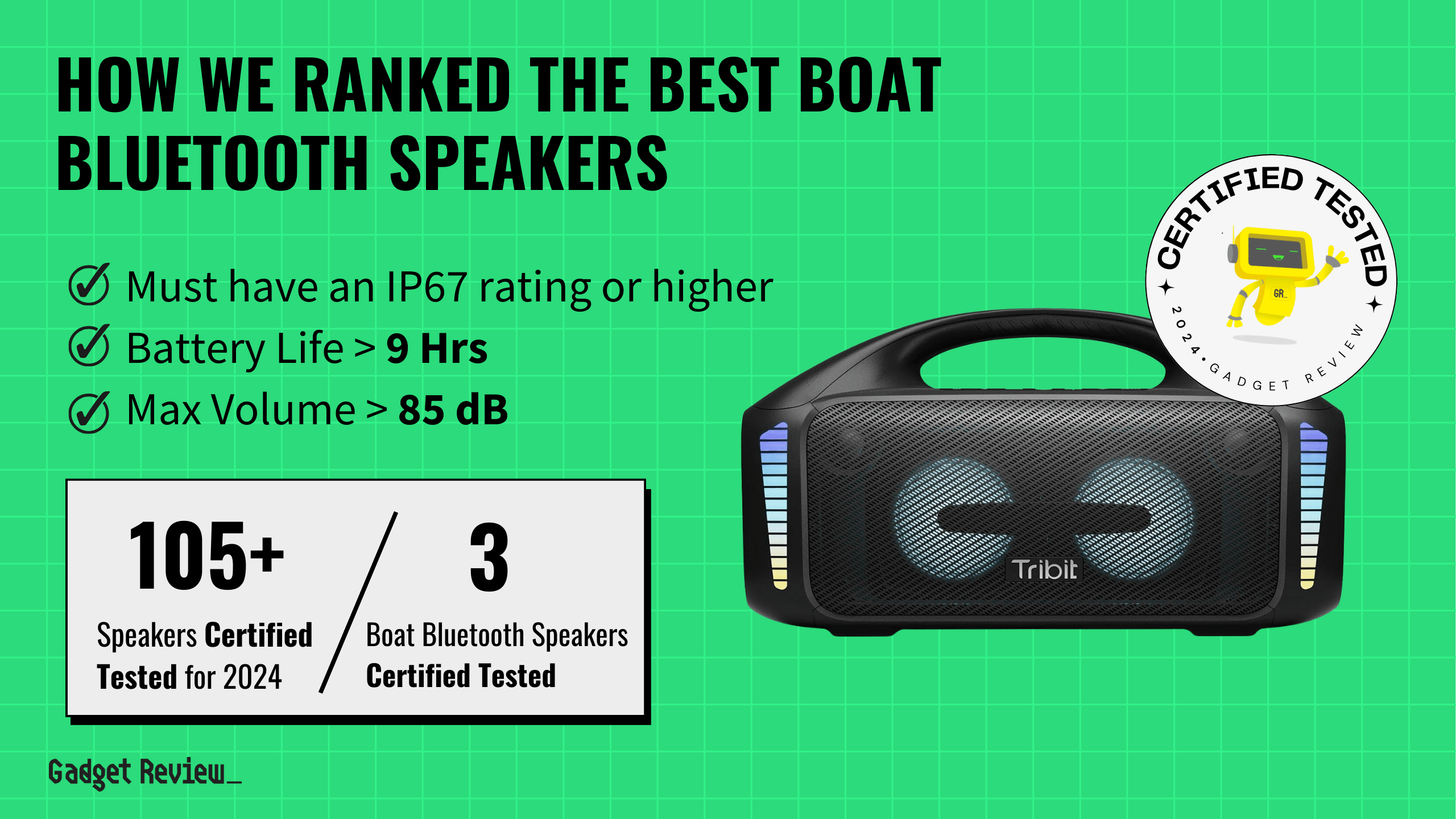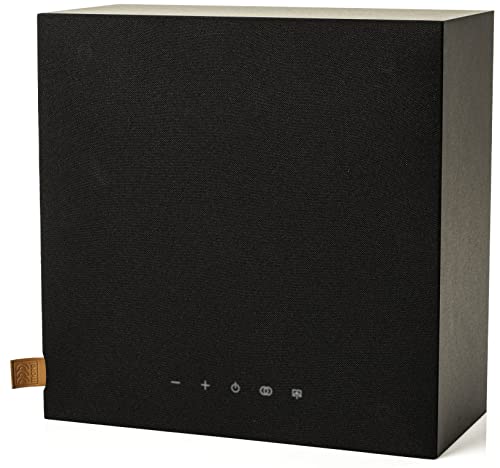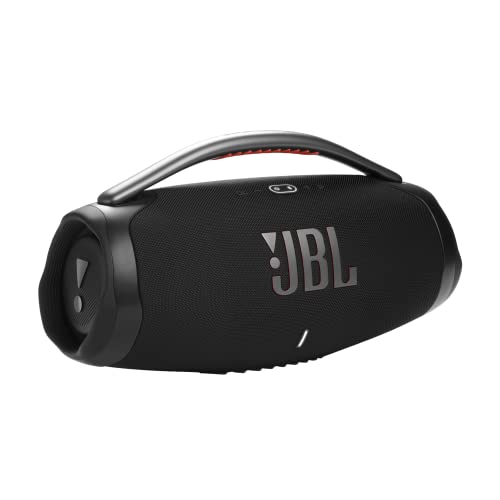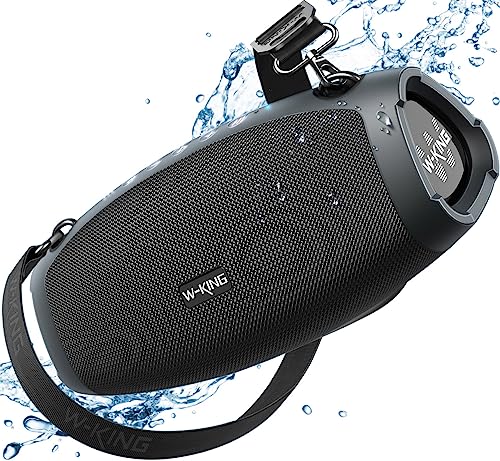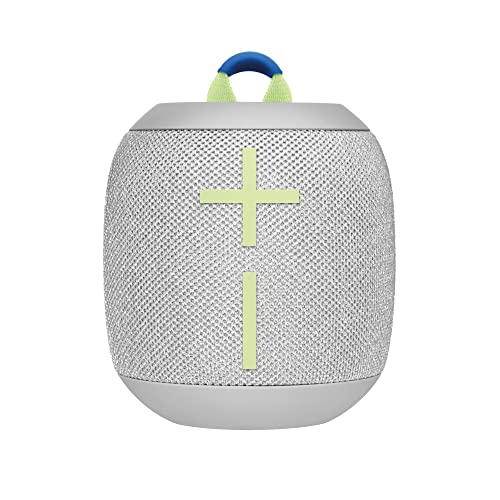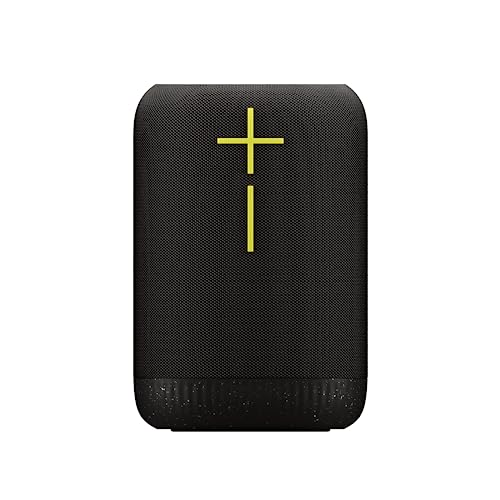The best center channel speakers will ensure you hear everything while watching videos — from dialogues to subtle sound effects and other audio elements that could otherwise go unnoticed. These are among the best speakers for a clean and balanced acoustic array, immersing you into every action-packed scene as though it were taking place right in your living room.
These speakers have a compact and slim design with top-quality two or three-way drivers made of either silk, titanium, or aluminum for the ultimate listening experience. Moreover, their incredible vocal accuracy and frequency response make them ideal for boosting dialogue clarity from an anchor point in any home theater setup.
Keep reading our buying guide to learn everything about center channel speakers, and why they are arguably the most significant speakers you’ll ever own.
Top Center Channel Speakers
#1 Klipsch R-52C Powerful Detailed Center Channel Home Speaker
Award: TOP PICK
WHY WE LIKE IT: It is engineered to make dialogues clear and audible. It also has a high-quality cabinet that is designed to limit vibrations even at high volumes. Its sound quality is well balanced, and its design is quite laidback.
- Great for dialogues
- Delivers a well rounded sound
- High quality cabinet is designed to minimize vibrations
- Large size may make it inconvenient to place
The Klipsch R-52C is a premium-looking central channel engineered to deliver the most precise vocals so that owners can discern dialogue clearly. This is important for movie watchers who want to latch on to every word or music enthusiasts who want to be entirely in sync with song lyrics. The center channel consists of a 1-inch Aluminum tweeter that minimizes distortion and dual 5.25-inch IMG woofers that deliver a super low-frequency response. However, its large size might bring about issues during placement.
The speaker’s use of Tactrix horn technology ensures that frequency vibrations are aimed directly at the listener and spun copper IMG woofers that maintain impressively low bass levels for a well-rounded sound. The speaker can handle a maximum of up to 400 Watts and has a sensitivity rating of 95 dB. Owners can also opt to remove its front grille if they wish to, and since it is also made of a reinforced MDF construction, vibration is minimal even at the highest volumes.
#2 Polk Audio T30 100 Watt Home Theater Center Channel Speaker
Award: HONORABLE MENTION
WHY WE LIKE IT: Its volume can be changed independently from other speakers, and it also produces impressive bass levels. The build quality is pretty good, and its black oak finish makes for a very attractive look.
- Impressive bass levels
- Volume can be changed independently from the other speakers
- Great build quality
- Distortion reported at high volume levels
The Polk Audio T30 delivers an immersive listening experience, with a firm focus on crystal clear vocals for accurate dialogue. The speaker consists of one 1-inch silk dome tweeter, two 5.25 composite drivers, and a rear-firing bass port that handles low frequencies. The speaker’s construction also screams of impressive build quality, and with support for both Dolby Atmos and DTS sound technologies, the center channel is well poised to deliver cinema-quality sound. Unfortunately, some previous users have reported incidences of distortion, especially at high volume levels.
When it is part of a surround sound setup, the center speaker can be turned up higher than the others or even be turned down for the others to be more audible. Its black oak finish allows it to blend in pretty quickly with other speakers from the Polk family, and since its front grille is removable, owners can opt to have the drivers in full view or have them stay out of sight.
#3 Yamaha Audio NS-C210BL Center Channel Speaker
Award: BEST FOR GENERAL USE
WHY WE LIKE IT: It delivers a decent bass response since it has a back-firing bass port, and since it is wall mountable, owners have a lot more flexibility in terms of where they can place it.
- Decent bass response
- Wall mountable
- Light at 4.4 pounds
- Front grille is not removable
The Yamaha Audio NS-C210BL is a two-way center channel speaker that can handle an impressive 120 Watts of power at peak. It has two 3.1-inch cone woofers for low bass levels and a 0.9-inch balanced dome tweeter that delivers high-frequency responses. It also has an impedance of 6 Ohms and can get as loud as 86 dB. The speaker weighs a light 4.4 pounds, and since it also has keyhole type brackets, owners will also be able to mount them on a wall. However, its front grille is not removable.
The center channel also features a back-firing bass port and good treble definition to keep dialogues audible. It has a frequency response rate of 65Hz to 45kHz, and a sleek, slim design that will fit nicely into a set that has modern decor. The speaker also has banana inputs, and its small footprint makes it very easy to position. The sound quality is pretty good, and its all-black finish gives it a premium look.
#4 Pioneer SP-C22 Andrew Jones Home Audio Center Channel Speaker
Award: BEST FOR DESIGN
WHY WE LIKE IT: It is very well designed and has a curved cabinet design that reduces standing sound waves and 4-inch drivers that deliver impressive bass levels. Thanks to its six-element complex crossover, the sound produced is also very accurate.
- Six element complex crossover for impressive sound accuracy
- Decent bass levels thanks to its 4-inch subwoofers
- Wide frequency response range
- Cannot wall mounted
Designed by Andrew Jones, the Pioneer SP-C22 is a great-looking center channel speaker that can handle up to 90 Watts peak power and comes in a curved cabinet design that results in a stiffer cabinet wall. It consists of two 4-inch woofers and is capable of a frequency range of between 55Hz and 20kHz. Its 4-inch drivers deliver impressive bass levels, and its crossover emphasizes the sound detail in the audio quality. Still, it cannot be wall-mounted.
Owners will also be able to hear vocals accurately thanks to the speaker’s accurate dialogue, and its curved cabinet design works to reduce standing sound waves inside. Its walnut black wooden finish will blend in with modern decor, and with a sensitivity rating of 88 decibels, it can produce room-filling sound.
#5 Micca MB42-C Center Channel Speaker
Award: BEST FOR COMPACT DESIGN
WHY WE LIKE IT: It is pretty compact, allowing for easy placement, and has a high-performance silk dome tweeter for accurate trebles.
- Compact design for easy placement
- Dual carbon woofers for low midrange distortion
- Clear vocals
- No built in crossover unit
The Micca MB42-C center channel speaker can be a worthwhile upgrade for anyone looking to improve their home theater system. It is pretty compact and will do a lot towards enhancing vocals and ensuring that dialogues are more audible. The speaker also does a lot to add to the bass response of the system that it gets connected to, and with dual 4-inch balanced woven carbon fiber woofers, its midrange distortion is relatively low. Unfortunately, it does not have a built-in crossover unit.
The speaker also features a silk dome tweeter for delivering a smooth treble and full-size binding posts for easy wire connections. Its classic cloth grill design and rounded corners give it a very sophisticated design, and its compact design makes for easy placement. It has a decent sensitivity rating of 86dB and a frequency response range of 60Hz to 20kHz.
#6 Sony SSCS8 2-Way 3-Driver Center Channel Speaker
Award: BEST FOR SOUND ACCURACY
WHY WE LIKE IT: Its sound delivery is very accurate, and its super tweeter keeps high frequencies crisp and clear. Installing it is also pretty easy to do.
- Excellent sound accuracy and detail
- Impressive power handling capacity
- Delivers powerful bass levels
- Cannot be wall-mounted.
The Sony SSCS8 is a 2-way 3-driver Center Channel speaker that’s ideal for users who prioritize high sound accuracy and has an impressive power handling capacity of up to 145 Watts. The speaker has two 4-inch woofers and a 1-inch tweeter that, when put together, deliver natural-sounding vocals. The speaker also features high-quality crossover networks that prevent excessive loss of vocal responses, and its powerful bass response ensures that low frequencies are accurately rendered with no exaggerations. However, it cannot be wall-mounted.
This speaker has an impedance of 6 ohms, and its sensitivity is rated at 86dB. Its frequency range of response is also pretty wide at between 55Hz to 25kHz, and weighing 11 pounds, its heavier than other central channels but not heavy enough to make it challenging to handle.
Beginner’s Guide to Center Channel Speakers
What is a Center Channel Speaker?
A center channel speaker is the most essential component in a surround sound setup because it delivers almost all the dialogue in videos. It’s placed below the TV and is connected to a receiver and an amplifier to reproduce crisp dialogues that stand out among the other sound effects in a movie.
Center Channel Speaker vs. A Soundbar Speaker
If you didn’t know any better, you could easily mistake a center channel speaker for a soundbar. Both these devices have a horizontal, sleek build and can be found sitting under or on top of a TV to emanate sound from the center of your room. However, they are worlds apart in amplification abilities and audio quality.
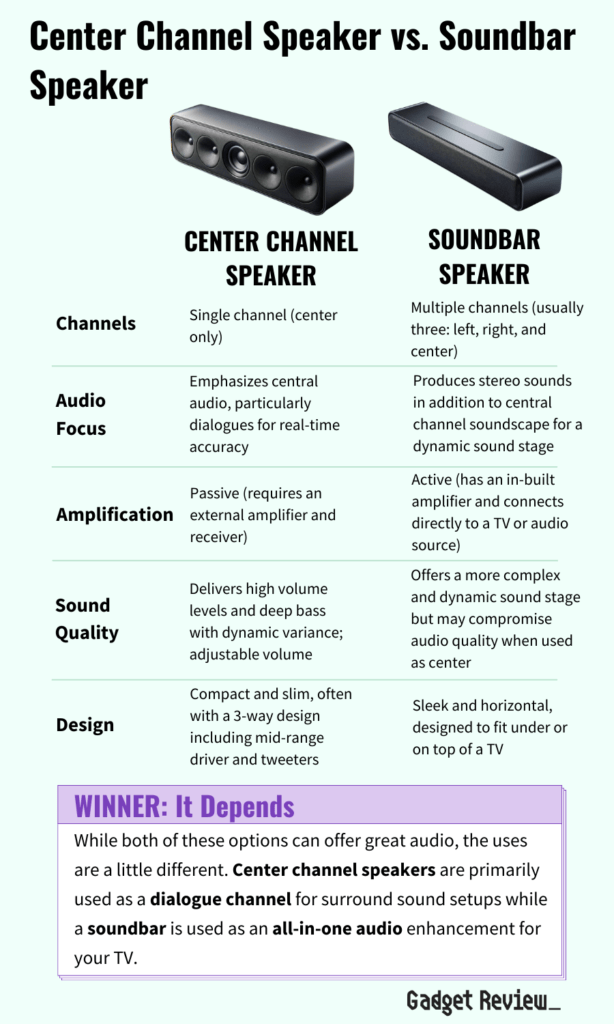
| Feature | Center Channel Speaker | Soundbar Speaker |
|---|---|---|
| Channels | Single channel (center only) | Multiple channels (usually three: left, right, and center) |
| Audio Focus | Emphasizes central audio, particularly dialogues for real-time accuracy | Produces stereo sounds in addition to central channel soundscape for a dynamic sound stage |
| Amplification | Passive (requires an external amplifier and receiver) | Active (has an in-built amplifier and connects directly to a TV or audio source) |
| Sound Quality | Delivers high volume levels and deep bass with dynamic variance; adjustable volume | Offers a more complex and dynamic sound stage but may compromise audio quality when used as center |
| Design | Compact and slim, often with a 3-way design including mid-range driver and tweeters | Sleek and horizontal, designed to fit under or on top of a TV |
| Frequency Response | Can deliver a wide frequency range, e.g., 90Hz-21kHz, for crisp highs and deep bass | Varies, but generally designed for a broad and immersive sound experience |
| Components | May include built-in woofers, titanium tweeters, and midrange drivers | Integrated speakers covering multiple channels without the need for external components |
| Ideal Use | Enhancing dialogue clarity and accuracy in a home theater surround sound setup | Providing a simplified, all-in-one solution for improved TV sound without multiple components |
As its name suggests, the center channel has only one channel compared to a soundbar, which boasts three channels (left, right, and center), much like a home theater surround sound. This means a center channel emphasizes central audio like real-time accuracy during dialogues. At the same time, a soundbar produces stereo sounds in addition to the central channel soundscape for a more complex and dynamic sound stage.
As for amplification, center speakers are passive, meaning they can’t amplify the soundtrack they produce independently. To that effect, you can hook these speakers can up to an amplifier and receiver. Once connected, they feature a dynamic variance that delivers high volume levels and deep bass. Plus, you can always adjust the volume levels of a center speaker independently of the other speakers for enhanced vocal clarity. On the other hand, a soundbar has to be directly connected to a TV or an audio source, as these active speakers have an in-built amplifier.
That said, technically, you can substitute a soundbar for a center speaker if you like. However, you’ll compromise audio quality because channel sound waves cause interference with the left and right speakers. Moreover, using an active soundbar to double over as a center channel means amplifying an already amplified note, which not only leads to dialogue distortions but can potentially damage other speakers in your home theater system.
How a Center Channel Speaker Works
To understand the workings of these speakers, it’s important to note that a surround sound setup comprises a minimum of 5.1 channels — front left and right, surround left and right, a subwoofer (.1), and a dedicated center.
During a movie’s post-production, editors assign all dialogues to the center channel for reproduction. But in the absence of a dedicated center speaker, the dialogues get disbursed between the front left and right speaker. As a result, it becomes difficult to control the sound positioning and volume of the vocals if the background effects are too loud.
A compact center channel speaker usually has a 3-way design, and you’ll find a mid-range driver and soft dome tweeter located one above the other, flanked by dual woofers. The built-in woofers and titanium tweeters reproduce higher (2000 to 20000 Hz) and lower (40 Hz to 500 Hz) audio frequencies respectively, while the midrange driver produces sounds that fall into the range of 250 to 2000 Hz for accurate reproduction.
These three components work together to create an immersive listening experience and powerful sound signature by accurately reproducing a wide frequency range.
You’ll be surprised to find that these slim and compact speakers can deliver an impressive 90Hz-21kHz frequency response range for crisp highs and deep, heart-pounding bass. They also feature a dual power port for effortless bass. As you move up the price spectrum, you’ll also find vented titanium soft-dome tweeters and copper woofers for better damping and crystal-clear highs.
Why Should You Buy a Center Channel Speaker?
If you’re an audiophile looking to amp up your audio experience to replicate the excellent performance of a cinema hall sound stage, a center channel is a perfect option. Its 2-way 3-driver center channel, sleek design, dynamic balance drivers, and high-frequency response make for a perfect at-home cinematic sound experience that boosts dialogue clarity and promotes spatial sound reproduction.
Are Center Channel Speakers Worth Buying?
- You Only Have a Two-Channel Stereo: If you want to move from a stereo to a home theater surround sound to churn out rich vocals, a dedicated center channel is your go-to. Use quality RCA cables to connect your AV receiver or amplifier to this center channel speaker to create a seamless sound stage with a dynamic range that matches the tonality of your front left and right speakers.
- You Prioritize Movie Dialogue Clarity: No movie is the same without clear, powerful-sounding vocals. The center channel is key for crystal-clear dialogue reproduction that otherwise tends to get scattered and distorted between the left and right speakers.
- You Want To Upgrade From a Soundbar: Though soundbars are a cheaper option, chances are you’ll miss out on the high-quality sound you’d get with full-fledged surround sound speakers.
Why a Center Channel Speaker May Not Be for You
- Your Use Is Mainly For Music: If you need speakers for music listening, you’ll do well with a two-channel stereo. If you need something for your car, you’ll want the best car speakers for bass, since most music is recorded in stereo and not surround sound
- You Are On a Tight Budget: Sometimes, due to tight budgets, people settle with just the front L/R speakers for vocal reproduction. Although you may be able to hear the dialogues, the experience won’t be as immersive and clear as it would be with a center channel speaker.
How Long Will a Center Channel Speaker Last?
Among all audio products, speakers are known to last the longest. There is no exact figure for the longevity of a center channel speaker, but based on consumer reviews, you can expect it to operate for a decade or more.
With proper maintenance and care, it’s possible to improve the performance of center speakers and add a few more years to its life. First, avoid playing blaring music or sounds all the time. Constant exposure to extreme vibrations can damage internal parts, including the drivers.
And once you decide on an ideal placement position for your center speaker, stick to it. Don’t move it around to prevent it from falling or coming in contact with water. Lastly, just as you would with the best DJ speakers, clean them of dust and other particles that can come in the way of the sound waves’ trajectory for optimal clarity and long life.
How to Choose a Center Channel Speaker
While buying a center channel speaker is essential for getting the best sound quality, you can’t just choose the biggest and most attractive design on the market. Below are crucial factors that you must consider before investing in one.
Best Center Channel Speaker Key Factors
1. Is Your Center Channel Speaker Compatible With Your Other Speakers?
If your room’s already equipped with surround speakers and you only require the center channel speaker to complete your setup, you’ll have to ensure that the center speaker is acoustically aligned with the others.
To put it simply, it’s best to buy the center channel speaker from the same brand that you have purchased your other surround sound equipment from. It would help even more if it’s from the same series that the other equipment belongs to.
Since the speaker components are different for different manufacturers, frequency reproduction may be inconsistent. When the products are similar, detailed sound can travel smoothly from one speaker to another. Otherwise, you’ll constantly have to deal with an unbalanced and distorted soundscape. However, more premium devices showcase high versatility by seamlessly adjusting to different speaker models.
2. How Big Is Your Center Channel Speaker?
A large center channel home speaker almost always takes the crown when it comes to a home theater system. But not everyone has the budget to purchase it, and even if they did, they may have space limitations.
Speakers with the most compact design are around 7-inches, and you can easily place them above or under your TV without worrying about your surround sound system looking cluttered. Keep in mind, though, that super compact builds come at the cost of poor acoustic quality.
If space permits, you can go up a notch with 12-15 inch speakers that have considerably better sound clarity but are still small enough to fit perfectly in your mid-sized studio room.
Lastly, speakers over 30 inches have a modern design and produce spectacular spatial sound while offering a wider listening angle. So no matter where you’re sitting in the room, you’ll feel as though you’re right in the middle of the action.
3. Do You Have Space for the Center Channel Speaker?
The placement of a center channel home speaker can either make or break your surround sound experience. The center channel must be close to the TV, either above or below it, to give the audience an illusion that the dialogues are coming straight from the actor.
Another major placement option is bringing the entire speaker to the edge of the shelf. The last thing you want is to put the speaker deep inside a piece of furniture for the sounds to bounce off the walls and reach your ears as incomprehensible noises.
Additionally, angle the speaker so that the tweeters and woofers are ear level and pointing towards your face. This way, the sound travels directly to your ears for a high dynamic range that gives you a full-blown immersive experience.
4. What Additional Factors Should You Bear In Mind?
Apart from the key features mentioned above, the type of speaker material, sensitivity rating, and power range can influence the quality and durability of the center speaker you choose.
The drivers in the speakers can be made of different materials, from silk and titanium to aluminum and carbon fiber. These materials dictate the kind of sound your speaker will produce. For example, a silk dome tweeter emanates smooth sounds, while metallic varieties are more vibrant and high-pitched.
Speakers with a high sensitivity rating can easily achieve loud volumes compared to speakers with a low sensitivity rating. The ideal choice is a sensitivity rating of 90 dB or greater for a more rich audio signature.
Before purchasing a center speaker, check the RMS wattage of your receiver. Only buy it if the figure falls within the power range of the speakers.
5. What’s your Budget?
Affordable speakers can be found at $60-$80 price points, while more expensive models with deeper bass response and realistic reproduction are close to $500. Though affordable prices are great for those on tight budgets, these models usually have a weaker bass or unrefined and muddy sound due to the budget construction with poor quality composite drivers and internal parts.
Moving up the price range, you’ll find a wide power range for higher flexibility so that the speakers can blend well with other devices in your surround sound system to avoid sound clashes. Not to mention, you’ll also enjoy speakers with a slim profile design, rich sound, best-in-class frequency and bass response, and drivers made of superior materials.









